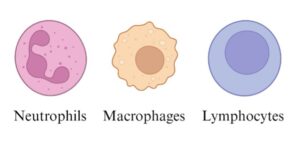Carmen M. Burner – Graduate Assistant, UGA Animal and Dairy Science Department (carmen.burner@uga.edu)
Valerie E. Ryman, PhD, PAS – Lecturer, Department of Physiology and Pharmacology, CVM, UGA (vryman@uga.edu)
As many know, mastitis is defined as inflammation of the mammary gland commonly caused by bacterial infection. The most recognizable form, clinical mastitis, is detected by visual abnormalities in the milk and/or udder. However, subclinical mastitis (SCM) which is defined as a somatic cell count (SCC) of ≥ 200,000 cells/mL with no visual abnormalities to the milk, may go undetected due to a lack of visible signs. The most efficient way to control mammary health and limit economic impact of SCM is through an effective mastitis management program, which includes targeted diagnostics (such as culturing) for better decision-making. Though SCC remains a critical piece of the puzzle in detecting SCM, there are limitations to its utility in this context. For example, SCC tends to increase throughout lactation and across parity (number of times a cow has calved). Moreover, various stressors and physical traumas to the udder can contribute to increases in SCC, even in the absence of microbes. Administration of antibiotics to quarters with increased SCC alone may result in overuse of antibiotics, depletion of farm resources, and increased disease costs.
Dairy professionals are looking into ways to improve SCM detection not only for animal health, but to aid in better selective treatment for potentially affected animals. In recent years, the investigation of a new method could be the missing puzzle piece to a breakthrough in detection of SCM. Ongoing research at the University of Georgia is focused on the utilization of differential somatic cell counts (DSCC) as a tool for detecting SCM caused by infection to help aid in judicious use of antibiotics.
What exactly is DSCC?
Most producers are familiar with the term SCC, which gives the total number of body cells per milliliter. The composition of SCC is predominately white blood cells (leukocytes) and a small number of mammary epithelial cells (milk-producing cells of the udder). Common populations of white blood cells found within milk include neutrophils, macrophages, and lymphocytes (Figure 1). In contrast to SCC, a DSCC is focused on the distribution of white blood cells, typically evaluated in percentages of total cells. For example, a milk sample may have a SCC of 300,000 cells/mL (indicating possible SCM) and a DSCC of 40% neutrophils, 50% macrophages, and 10% lymphocytes, depending on the technology and equipment used (more likely indicating an active infection is not happening given low % neutrophils; see following section). This distribution can give a better insight to the possible presence of an infection, compared to the SCC alone.
Immune Response in the Mammary Gland
To better appreciate the information gained from DSCC, it is important to first understand the role of white blood cells, especially their role in an infection.
In a healthy mammary gland, the white blood cell population will predominantly consist of macrophages. Think of the macrophage as a sentinel in this context. When a pathogen enters the udder, macrophages alert the body of the foreign microbe and begin the process of an innate immune response. The primary step of innate immunity is inflammation and involves mass recruitment of neutrophils. The job of a neutrophil is to eat and kill the microbe. After neutrophils have performed their job, they will die, which macrophages then clean up. In the immune response, lymphocytes are mainly responsible for the production of memory cells and antibodies…think about vaccinations… however their role in the mammary gland appears to be limited for mastitis.

Implications of DSCC
Previous research in humans found an association with neutrophil levels and severity of a disease. When looking at patients diagnosed with coronary artery disease (CAD), those with a higher ratio of neutrophils to lymphocytes had more advanced obstructive CAD and had a higher rate of major cardiovascular disease events throughout 3 years of follow-ups. (Arbel et al., 2012) Some studies have also shown that patients with an increased percentage of neutrophils correlated with a negative medical outcome compared to patients with less elevated neutrophil percentages. For example, patients diagnosed with breast cancer with a higher ratio of neutrophils to lymphocytes had higher 1-year and 5-year mortality rates compared to those with lower ratios (16% vs 0% and 44% vs 13%, respectively) (Azab et al., 2012). Furthermore, prolonged presence of neutrophils can create a detrimental cycle of tissue damage resulting in improper healing of a wound. The question here is that in a quarter with chronically elevated neutrophils, could that elevation contribute to tissue damage the same or more than the microbe itself? Is the elevation in neutrophils contributing to poor antibiotic outcome?
The concept of DSCC as a marker for diseases is not new to the medical field. In fact, evaluating the distribution of body cells has been used in numerous cases in other animal species as well as human medicine. For example, a complete blood count test (CBC) is a blood test utilized by many veterinarians to evaluate the different cell types within blood samples to detect underlying illnesses. In addition, looking at the distribution of elevated white blood cells is the backbone for diagnosing cancer in humans. Researchers have seen the value of DSCC in other fields and have recently been assessing its potential in the context of mastitis in dairy cattle.
There are a handful of products or technologies currently on the market that assess DSCC in dairy cattle. The DSCC (Advanced Animal Diagnostics) technology being utilized at the University of Georgia is the QScout® Farm Lab. It uses a producer-friendly interface that gives positive and negative readings for SCM on both a cow and quarter level. The benefit to an on-farm machine such as the QScout® Farm Lab is that it allows for quick response times on samples leading to rapid decision making for the producer. However, QScout® Farm Lab is not necessarily a high throughput machine, meaning running large numbers of samples can become time consuming for a producer. The cost per cow to run a DSCC sample is $5/cow which is less than the cost of running SCC on individual quarter samples utilizing a DeLaval direct cell counter at $10/cow. Research from other institutions and companies are looking at the use of high throughput DSCC machines with a structure to allow for implementation of this technology into monthly Dairy Herd Information Association (DHIA) testing.
Being able to have an understanding about the cellular dynamics of the udder through the use of DSCC can help producers make more guided decisions on administering antibiotics. For example, perhaps our research shows that an elevated percent of neutrophils is strongly related to a failure to cure after antibiotic treatment. This information could aid producers in weighing the odds of a quarter curing, and therefore treatment is “worth it”, or withholding treatment and evaluating whether that animal should be culled. Overall, these are just some of questions being at explored at the University of Georgia and other institutions. DSCC has the ability to propel the industry forward in the realm of SCM management as well as show consumers a continued effort by the dairy industry to use antibiotics safely and judiciously.
References
Arbel, Y., A. Finkelstein, A. Halkin, E. Y. Birati, M. Revivo, M. Zuzut, A. Shevach, S. Berliner, I. Herz, G. Keren, and S. Banai. 2012. Neutrophil/lymphocyte ratio is related to the severity of coronary artery disease and clinical outcome in patients undergoing angiography. Atherosclerosis 225(2):456-460.
Azab, B., V. R. Bhatt, J. Phookan, S. Murukutla, N. Kohn, T. Terjanian, and W. D. Widmann. 2012. Usefulness of the neutrophil-to-lymphocyte ratio in predicting short- and long-term mortality in breast cancer patients. Ann Surg Oncol 19(1):217-224.
